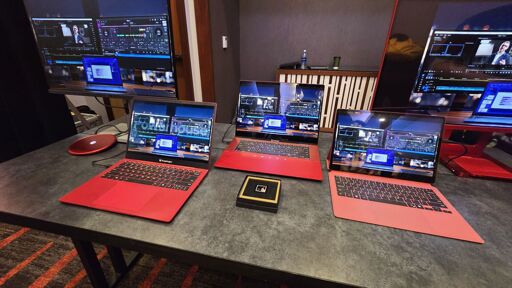…In Geekbench 6.5 single-core, the X2 Elite Extreme posts a score of 4,080, edging out Apple’s M4 (3,872) and leaving AMD’s Ryzen AI 9 HX 370 (2,881) and Intel’s Core Ultra 9 288V (2,919) far behind…
…The multi-core story is even more dramatic. With a Geekbench 6.5 multi-core score of 23,491, the X2 Elite Extreme nearly doubles the Intel Core Ultra 9 185H (11,386) and comfortably outpaces Apple’s M4 (15,146) and AMD’s Ryzen AI 9 370 (15,443)…
…This isn’t just a speed play — Qualcomm is betting that its ARM-based design can deliver desktop-class performance at mobile-class power draw, enabling thin, fanless designs or ultra-light laptops with battery life measured in days, not hours.
One of the more intriguing aspects of the Snapdragon X2 Elite Extreme is its memory‑in‑package design, a departure from the off‑package RAM used in other X2 Elite variants. Qualcomm is using a System‑in‑Package (SiP) approach here, integrating the RAM directly alongside the CPU, GPU, and NPU on the same substrate.
This proximity slashes latency and boosts bandwidth — up to 228 GB/s compared to 152 GB/s on the off‑package models — while also enabling a unified memory architecture similar in concept to Apple’s M‑series chips, where CPU and GPU share the same pool for faster, more efficient data access…
… the company notes the “first half” of 2026 for the new Snapdragon X2 Elite and Snapdragon X2 Elite Extreme…



linux on arm is not mature. on windows, typically emulation of x86 is used. They’ll need to also support all of the gpu libraries for gaming.
Desktop linux on arm*. The kernel itself has been running on embedded arm deviced for 25 years and on a large portion of phones for 15.
The question was about GPU drivers, and GPU drivers for ARM-based SoCs aren’t even mature on Android. They are going to suck on Linux.
Compared to the drivers for Mali, Adreno and consorts, Nvidia is a bunch of saints, and we know how much Nvidia drivers suck under Linux.
Asahi linux is perhaps only distro that is trying to support “desktop arm”. Not just gpu, but it does not post for M3/M4 arm chips. Qualcom does not have an OS protection racket, and so could be more helpful to the project, but phone support (limited/tailored to each chip generation it seems) doesn’t seem to mean all future arm automagically supported.
There are quite a few more. For example Debian, Ubuntu, Manjaro, Arch, Fedora, Alpine and Kali also have ARM ports (and probably many others too). Raspberry OS is purpose-built for ARM Desktop. There’s others too.
Asahi isn’t specifically an ARM Linux, but an Apple Silicon Linux.
Apple Silicon is ARM, but it’s also its own semi-custom thing that’s not directly compatible with other ARM stuff.
That’s the main issue with supporting ARM: You don’t have one platform like x86/x64.
On x86/x64 there’s an abstraction between the machine code language and the microcode that’s actually executed in the CPU. There’s a microcode translation layer in the CPU that translates one to the other, so x86/x64 chip designers have a lot of freedom when designing their actual CPU. The downside being that the translation layer consumes a little bit of performance.
There’s also the UEFI system and a ton of other things that keep the platform stable and standardized, so that you can run essentially the same software on a 15yo Intel CPU and a modern AMD.
ARM is much more diverse. Some run Devicetree, some don’t. There are also multiple different ARM architectures, and since they are customizable, there’s just so much variety.
thank you for correction. Do any linux distributions support qualcomm’s first (last gen) “elite win/chorme books?”
I don’t have personal experience with that, but according to google (https://www.linaro.org/blog/linux-on-snapdragon-x-elite) it is at least a thing.
Wouldn’t expect it to be great though.